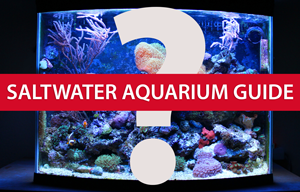Saltwater aquarium owners will eventually need to control phosphate levels in their aquariums. Phosphate is a nutrient found in aquariums that feeds algae and inhibits calcification of invertebrates and corals.
Phosphate control can help to reduce the amount of algae that grows in an aquarium and will maximize coral growth in saltwater aquariums.
Many aquarium owners might not fully understand the the benefits of phosphate control and therefore might not practice it in their normal aquarium maintenance activities. If you have an established saltwater aquarium that is starting to have regular problems with algae growth, it’s probably time to start making a conscious effort to control phosphate levels.
Preventing High Phosphate Levels
The first step in battling phosphate levels in an aquariums is to try to prevent the amount of phosphates that are in the aquarium in the first place.
Using purified water that has gone through the process of reverse osmosis is the first step you should take. Buy a reverse osmosis water purifier and use it to purify all water that you will be putting in your aquarium.
If you do not want to buy or utilize a reverse osmosis water purifier you should find some place where you can purchase purified water. Grocery stores or maybe even pet stores (that sell fish) should be able to provide you with a source to purchase purified water.
Reducing High Phosphate Levels
If you already have high phosphate levels in your aquarium, simply switching over to purified water probably won’t help much. The rate at which you add new water to your aquarium will not allow you to fully swap in purified water over a short period of time.
You will need to use phosphate removal media in your aquarium to filter out all the phosphates. There are several types of phosphate removal media available from aquarium supply dealers. Take a look online at any aquarium supply dealer and you should be able to easily find some phosphate media. It usually is lumped in the same category as other chemical removal media such as activated carbon.
When purchasing phosphate removal media be sure to check the specifications of the brand you are using. The media may behave differently from brand to brand. Some phosphate media will require that you remove or replace it within days to prevent leaching of the phosphates back into the aquarium water. Other phosphate media may not need to be replaced as soon, if at all.
Implementing Phosphate Removal Media
Phosphate removal media can be implemented into your aquarium in different ways.
The first method would be to buy and install a phosphate reactor. A phosphate reactor is simply a chamber that sits within the water filtration flow of your aquarium and has an intake and outtake. The chamber is filled with phosphate removal media, which the aquarium water will flow through continuously. Phosphate reactors can be hooked up in the existing water flow plumbing of your aquarium or you can usually hook up a separate powerhead intake and outtake into your aquarium if needed.
A second method would be to buy some mesh media bags and use your current sump filter or cannister filter. Fill the mesh bags with phosphate removal media and place them inside your cannister filter or sump filter. The mesh bags will prevent the phosphate pieces from getting all over the place in your filtration system and will make maintenance and implementation of the media much more easy to handle. The phosphate media will then be in the main water flow of your aquarium filtration system.
Once you have implemented phosphate prevention and removal techniques for a period of time, you should notice a decrease in the amount of nuisance algae in you aquarium. You may not need to clean your aquarium as often and your aquarium water quality will be improved.



